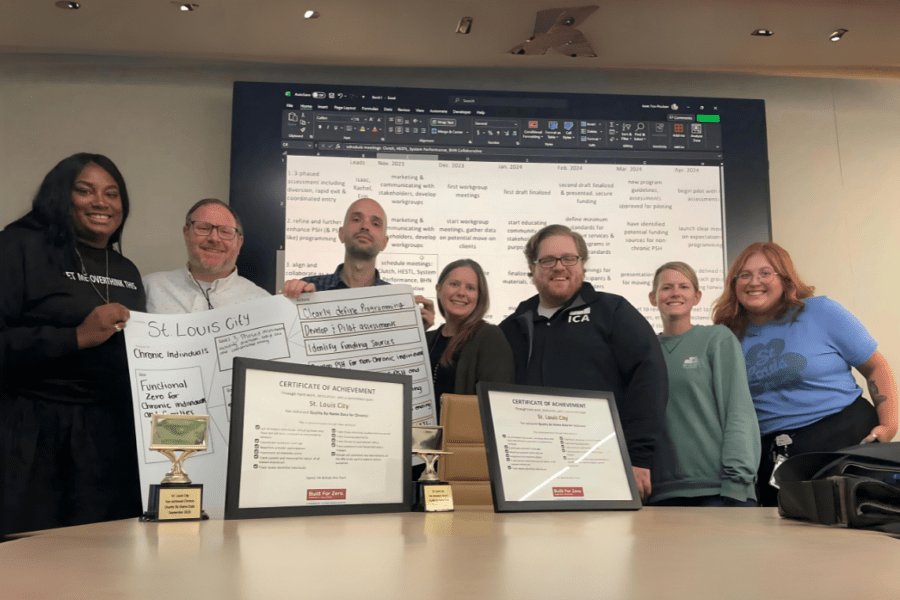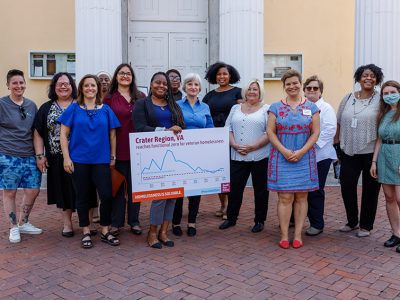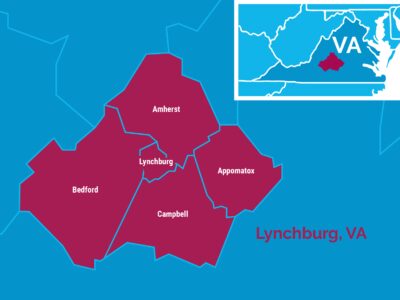In a city the size of St Louis, understanding the full scope of a problem like homelessness can make the challenge seem daunting.
But having reliable, accurate, and real-time data on everyone experiencing homelessness can also present a unique opportunity: to demonstrate how people and organizations across the community can all be a part of the solution.
“When having conversations with landlords and housing providers — having that information and having that data point really conveys the level of need,” said Ella Gross, Tenant Screening Manager at Tower Grove Community Development Corporation.
“Because that number is so significant, I think it changes people’s perception of what they can do to help,” she explained. “Every housing provider can help reduce this number.”
Built for Zero’s quality by-name data milestone recognizes that St. Louis City has a comprehensive data source of every person experiencing homelessness within a specific population, updated in real-time.
St. Louis City’s accomplishment encompasses all single adults experiencing homelessness, which is a broader category that includes the subpopulations of veterans and people experiencing chronic homelessness, along with other single adults not part of those groups.
Quality data benefits not only the homeless response system itself but also the people currently experiencing homelessness in that community.
“As a former outreach worker, it really matters a lot to me that we acknowledge people who are out there. You can’t get people housed if you don’t acknowledge them or give them an avenue — so it’s the very first step. It’s essential,” said Teka Childress, Program Director at Gateway Housing First.
“Having that common goal that we’re all working on as a community really brings people together,” said Jonathan Belcher, Senior Director of Long-Term Transformation at St. Patrick Center. “It really generates a lot of excitement and passion, and it gets people to really work together to try to achieve that goal.”
Unsheltered in St. Louis City
Sitting at the junction of the Mississippi and Missouri Rivers, the city of St. Louis spans 62 square miles, with a population of roughly 300,000 people. In contrast, the neighboring St. Louis County occupies 523 square miles with around 1 million residents.
The city and county operate as separate Continuums of Care, meaning they each receive and distribute federal funding among their local homeless service providers.
Because the majority of the unhoused population is located in the downtown area of St. Louis City, most homeless service providers are necessarily located there. Moreover, the North and South sides of St. Louis City are starkly different regarding race and income discrepancies.
Over the last few years, many shelters across the city have permanently closed, and no new shelters have been opened in the city for the past 13 years. Visible chronic homelessness has become a point of friction in the community.

“Our challenges are how widespread our folks are right now who are unsheltered and the fact that we’ve lost shelter,” Childress explained. “And so we are having folks with higher acuity simply for leaving them out there so long.”
The St. Louis City CoC has been working to reduce veteran homelessness since 2016. After restructuring the homeless response system, the city’s Built for Zero team reignited efforts in 2021 to reduce homelessness across all populations. Now that they have been certified to have reached quality data on veteran, chronic, and all single adult populations, St. Louis City is pursuing functional zero for a specific population.
“Ultimately, our big focus at the moment is trying to end chronic homelessness,” explained Isaac Fox-Poulsen, Data Analyst at the Institute for Community Alliances (ICA).
As of March 2023, the city has 661 people in their dataset known to fall under the designation of chronic homelessness, which means an individual has a documented disability and has experienced homelessness for at least a year or repeatedly over three years.
“We have this really large number of chronically homeless individuals and families. But at least we know what that number is, and we can start from there to really begin addressing chronic homelessness as a community,” Belcher said.

“Built for Zero helped us just really think more strategically as a community and work better together as a community to address homelessness.”
– Jonathan Belcher
Policies, procedures, and coordinated outreach
To achieve the quality by-name data milestone, the St. Louis City team focused on improving a few crucial areas of how they operated. With an eye toward sustainability and cohesiveness of its homeless response system, the city began documenting more of its practices to create a more shared understanding of the larger goals.
“Built for Zero helped us just really think more strategically as a community and work better together as a community to address homelessness,” Belcher noted. “Prior to creating these policies and procedures, we did things more siloed as a community: one organization would be doing things differently than another organization.”
Building and maintaining effective outreach processes across a homeless response system is an essential component of the quality data standard. Coordinated outreach ensures everyone without shelter is known to the support system. In 2023, the city began to host a weekly meeting focused solely on coordinated street outreach, inviting frontline outreach workers to meet to discuss encampments, area coverage, and how to best engage their clients.
“We included every single person that we could in the decision-making process for creating policy and procedures,” Belcher said. “One of those was our street outreach teams. We thought it was critical to have the buy-in from them, because a lot of the work they are doing was extremely important to getting that quality data.”
Built for Zero team member Desiree King agrees. As CoC Director of House Everyone STL, they support the homeless services community at large and frontline workers in particular.
“I’m here to be able to say, ‘Hey, do you need me to go out with you? Is there training or things that we need to provide?’ I talk a lot with the outreach workers, because they see it on a daily basis: What is needed? What are we missing? And how do we help bring that to the forefront?” King said.
A coordinated effort
By-name data allows communities like St. Louis to measure homelessness in real time to make data-driven decisions, prioritize resources, and connect their neighbors with housing.
However, to ensure the measurement is reliable and accurate, the community’s agencies and providers must coordinate their efforts across programs and have the same shared source of data. In St. Louis City and many other communities, this is achieved by using a coordinated entry system, through which all providers allocate housing and services through a single process using standardized assessments and data procedures.
“Inputting data in coordinated entry allowed people who had previously gotten passed over dozens if not hundreds of times to actually be considered for housing openings, especially those on the streets,” Fox-Poulsen said. “In comparison to just the PIT count once a year, we are a lot closer than we’ve ever been to an actual account of those experiencing homelessness in our community.”
Fox-Poulsen is a data analyst for ICA, a nonprofit organization that functions as the lead agency or administrator of the homeless management information system in CoCs in over a dozen states and in 10 Built for Zero communities. ICA’s participation through Fox-Poulsen’s work has been instrumental in helping the community reach this milestone.
“Isaac really saw the value in the Built for Zero model, which has also helped us figure out how to have a better strategic partnership with ICA more broadly,” explained Dawn Moskowitz, Data Coach and Performance Advisor in Built for Zero. “Without ICA’s leadership, commitment, and dedication, St. Louis City wouldn’t have been able to get to quality data,” she said.
Leveraging their by-name list and coordinated entry system, the St. Louis City team launched WHAMM, or their Weekly Housing and Match Meetings. Like case conferencing, WHAMM meetings gather representatives from organizations and agencies in the system to discuss the top 100 clients and refer them to appropriate services and available housing options.
“Rather than just picking people on a relationship basis, we were able to prioritize those with the most needs first and get them into housing,” said Belcher. “All that has really helped us get to the point of having quality data.”

“In comparison to just the PIT count once a year, we are a lot closer than we’ve ever been to an actual account of those experiencing homelessness in our community.”
— Isaac Fox-Poulsen
Next up for St. Louis City
With solid data in hand, the St. Louis City team is poised to dive into the work and move the needle on chronic homelessness. In March 2024, the St. Louis CoC released its new strategic plan aimed at making measurable progress using the best practices of Housing First. They are striving to ensure that every person in the community has access to a safe and healthy place to sleep and is provided services like mental health support and quality medical care that meet their needs and choices.
Having confidence in their data allows St. Louis City to pursue necessary housing and services for some of their most vulnerable residents.
“Knowing what we’re working with as a community can really help us set goals and reach out to not only other homeless services but also to our funding community as well — private, public, and even federal funders — to help us ask for additional funding to really achieve our goals,” Belcher said.
“If you don’t know what you’re starting with, you really can’t set good goals and make good plans to address homelessness as a community.”
The St. Louis City team would like to thank all of the community agencies, organizations, and service providers who contribute data to their shared database in the collective work to end homelessness.
Youth in Need
Veterans Administration – St. Louis Hope Recovery Center
Gateway Housing First
House Everyone STL
Get Help
St. Louis City CoC
Tower Grove CDC
Institute for Community Alliances
St. Patrick Center




